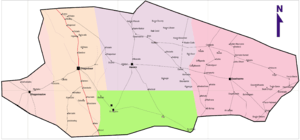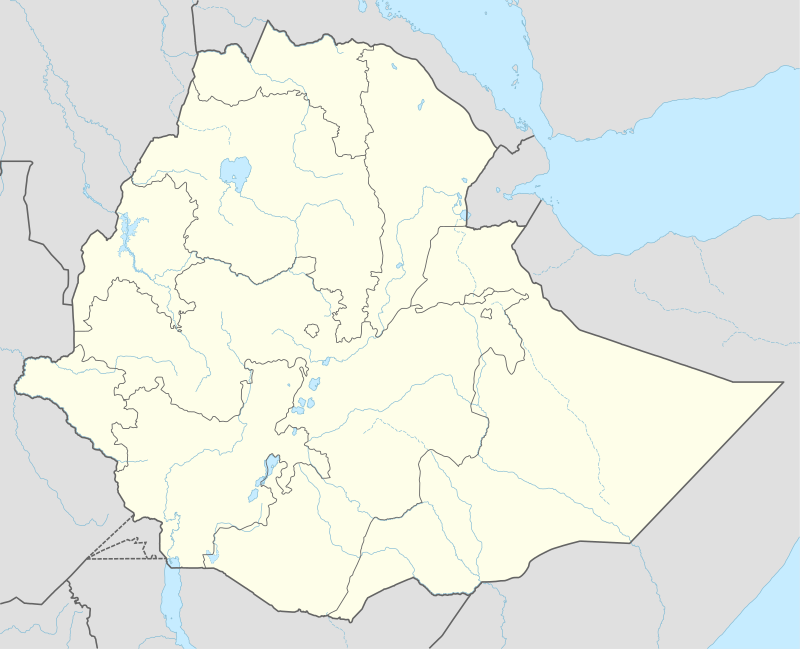Jarar Zone
Jarar Zone (Somali: Jarar) is one of the eleven zones in the Somali Region of Ethiopia. It was previously known as the Degehabur zone, so named after its largest city, Degehabur.[1] Jarar Zone is bordered on the south by Korahe, on the southwest by Nogob, on the northwest by Fafan Zone, on the southeast by Dollo, and on the northeast by Somalia.
Jarar Zone Gobolka Jarar | |
|---|---|
 Map of Jarar Zone | |
 Jarar Zone Location within Ethiopia | |
| Coordinates: 8°15′N 43°45′E | |
| Country | |
| Region | Somali |
| Zone | Jarar zone |
| Population (2017) | |
| • Total | 626,168 |
| Time zone | UTC+3 (EAT) |
Demographics
Based on the 2007 Census conducted by the Central Statistical Agency of Ethiopia (CSA), this Zone has a total population of 478,168, of whom 268,006 are men and 210,162 women. While 62,584 or 13.01% are urban inhabitants, a further 223,778 or 46.8% were pastoralists. The largest ethnic group reported in Jarar were the Somalis (98.92%); all other ethnic groups made up 1.08% of the population. Somali language is spoken as a first language by 99.62%; the remaining 0.38% spoke all other primary languages reported. 98.72% of the population said they were Muslim.[2]

The 1997 national census reported a total population for this Zone of 304,907 in 72,010 households, of whom 168,211 were men and 136,696 were women; 57,866 or 18.98% of its population were urban dwellers. The largest ethnic group reported in Jarar was the Somali (99.55%); a similar proportion spoke Somali (99.58%). Only 13,514 or 4.43% were literate.[3]
According to a May 24, 2004 World Bank memorandum, 1% of the inhabitants of Jarar have access to electricity, this zone has a road density of 10.3 kilometers per 1000 square kilometers, the average rural household has 1.5 hectare of land (compared to the national average of 1.01 hectare of land and an average of 2.25 for pastoral Regions)[4] and the equivalent of 1.5 heads of livestock. 28.2% of the population is in non-farm related jobs, compared to the national average of 25% and an average of 28% for pastoral Regions. 23% of all eligible children are enrolled in primary school, and 3% in secondary schools. 100% of the zone is exposed to malaria, and none to Tsetse fly. The memorandum gave this zone a drought risk rating of 614.[5] In 2006, the Jarar zone was affected by deforestation due to charcoal production.[6]
Districts
Jarar Zone is subdivided into eleven Districts
- Daroor
- Aware
- Dhagax-buur
- Dhagax-madow
- Gunagado
- Gashamo
- Birqod
- Dig
- Bilcil buur
- Araarso
- Yoocaale
Agriculture
On 5–23 November 2003, the CSA conducted the first ever national agricultural census, of which the livestock census was an important component.[7] For the Somali Region, the CSA generated estimated figures for the livestock population (cattle, sheep, goats, camels, and equids) and their distribution by commissioning an aerial survey. For the Jarar Zone, their results included:
| Animal | Estimated total | number per sqk. |
|---|---|---|
| cattle | 51,536 | 1.4 |
| sheep | 1,395,779 | 56.6 (including goats) |
| goats | 721,925 | 56.6 (including sheep) |
| camels | 131,106 | 3.5 |
| asses | 5,415 | 0.1 (all equids) |
| mules | 68 | 0.1 (all equids) |
| horses | 19 | 0.1 (all equids) |
Notes
- "Ethiopia" (PDF). USAID. Retrieved 20 August 2014.
- Census 2007 Tables: Somali Region Archived November 14, 2012, at the Wayback Machine, Tables 2.1, 2.4, 3.1, 3.2 and 3.4.
- 1994 Population and Housing Census of Ethiopia: Results for Somali Region, Vol. 1 Archived November 19, 2008, at the Wayback Machine Tables 2.1, 2.2, 2.13 (accessed 12 January 2009). The results of the 1994 census in the Somali Region were not satisfactory, so the census was repeated in 1997.
- Comparative national and regional figures comes from the World Bank publication, Klaus Deininger et al. "Tenure Security and Land Related Investment", WP-2991 Archived 2007-03-10 at the Wayback Machine (accessed 23 March 2006) This publication defines Benishangul-Gumaz, Afar and Somali as "pastoral Regions".
- World Bank, Four Ethiopias: A Regional Characterization (accessed 23 March 2006).
- CHF International, Grassroots Conflict Assessment in the Somali Region Archived July 26, 2011, at the Wayback Machine (Aug. 2006), p. 19 (accessed 12 December 2008)
- "Livestock aerial survey in the Somali Region" Archived 2011-07-16 at the Wayback Machine, CSA (November 2003), Tables 4, 6 (accessed 17 May 2009)